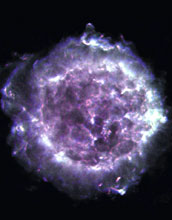Multimedia Gallery
Radio image of Cassiopeia A supernova remnant....
Radio image of Cassiopeia A supernova remnant.
More about this Image
Cassiopeia A is the remnant of a supernova explosion that occured over 300 years ago in our Galaxy, at a distance of about 11,000 light years from us. Its name is derived from the constellation in which it is seen: Cassiopeia, the Queen. A supernova is the explosion that occurs at the end of a massive star's life; and Cassiopeia A is the expanding shell of material that remains from such an explosion. This radio image of Cassiopeia A was created with the National Science Foundation's Very Large Array telescope in New Mexico. The image was made at three different frequencies: 1.4 GHz (L band), 5.0 GHz (C band) and 8.4 GHz (X band). Cassiopeia A is one of the brightest radio sources in the sky and has been a popular target of study for radio astronomers for decades. The material that was ejected from the supernova explosion can be seen in this image as bright filaments.
Investigators involved in this research were L. Rudnick, T. Delaney, J. Keohane and B. Koralesky; image composite by T. Rector. (Date of Image: 1994)
Credit: Credit L. Rudnick, T. Delaney, J. Keohane, B. Koralesky and T. Rector; NRAO/AUI/NSF
Special Restrictions: Use of NRAO/AUI names and/or logos in publicity, promotion or advertising is prohibited without prior written consent of NRAO/AUI. Commerical use will be considered on a case-by-case basis.
Images and other media in the National Science Foundation Multimedia Gallery are available for use in print and electronic material by NSF employees, members of the media, university staff, teachers and the general public. All media in the gallery are intended for personal, educational and nonprofit/non-commercial use only.
Images credited to the National Science Foundation, a federal agency, are in the public domain. The images were created by employees of the United States Government as part of their official duties or prepared by contractors as "works for hire" for NSF. You may freely use NSF-credited images and, at your discretion, credit NSF with a "Courtesy: National Science Foundation" notation.
Additional information about general usage can be found in Conditions.
Also Available:
Download the high-resolution JPG version of the image. (360 KB)
Use your mouse to right-click (Mac users may need to Ctrl-click) the link above and choose the option that will save the file or target to your computer.



